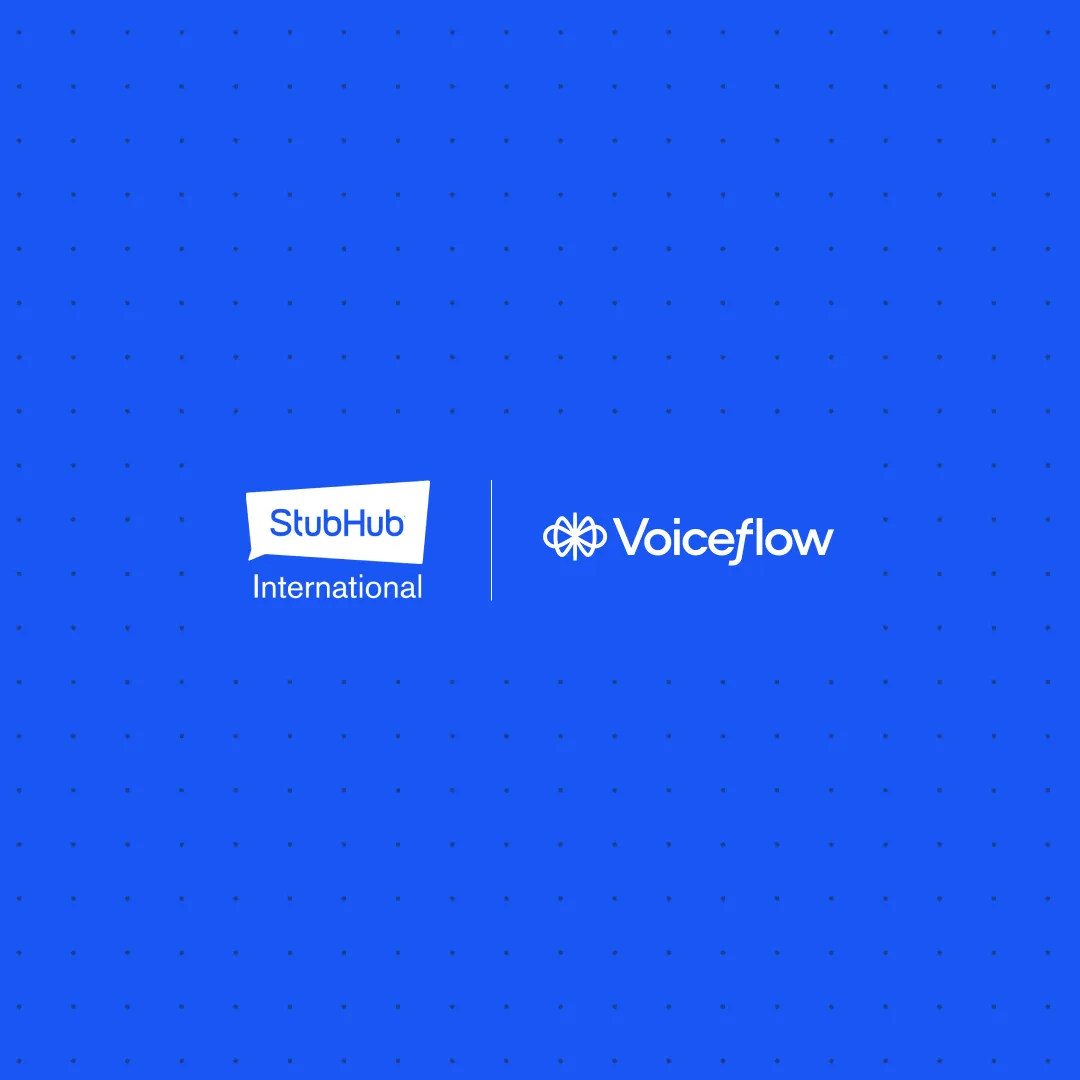The Challenge: Building Enterprise-Grade AI with Limited Resources
SHI faced three key challenges:
- Limited Technical Resources: With a small team and no dedicated engineering support, they needed a solution that non-technical staff could manage.
- Pressure to Launch: Their previous attempt to launch an AI agent had stalled due to complexity. They needed to move quickly to meet customer demands.
- Preserve Customer Experience: They wanted to enable self-service while maintaining high-quality customer interactions.
The Solution: Rapid Development with Low-Code Tools
StubHub International chose Voiceflow for its intuitive, low-code interface that would allow their customer support team to own the development process. "Because it has a drag-and-drop interface, it was very easy to work with," says Andreia. "It allowed us to rapidly iterate on conversational flows and reduce dependency on engineers."
A Phased Approach to Success
The most successful AI project teams start with a simple use case, prove value, and grow from there. This is the "crawl, walk, run" strategy used by the SHI team:
- Phase 1 - MVP Launch (2-3 months)
Getting from concept to build and live deployment took the SHI team under 12 weeks. In phase 1, the team prioritized high impact use cases and deployed the agent only in the “My Account” section to control for support volume and ensure smooth adoption. The first version of the agent was available only in English and focused on core intents and FAQ handling to deflect the most common customer questions.
This established a strong foundation for future expansion and validated the roadmap for the SHI team to continue investing in AI as a customer experience tool.
- Phase 2 - Expansion
In phase 2, the team added more complex use cases, like troubleshooting issues with customers, and expanded to additional site sections. Throughout, the SHI team could monitor responses through transcripts and refine the agent based on user feedback.
“Another thing that I really like about Voiceflow is how easy it is to trace the steps that led to the final answer,” shares Thiago Ramos, StubHub International’s primary agent builder. “I think this is crucial for learning and identifying opportunities for improvement.”
- Phase 3 - Full Scale
Now that the team has a solid foundation and has successfully expanded beyond the initial use case, they’re moving into planning multi-language support and exploring voice capabilities. Above all, the team is focused on continuous optimization and iteration, so the agent continues to deliver high quality experiences.
"This is a work in progress," Andreia emphasizes. "We're committed to evolving our AI agent and continuing to enhance the customer experience."
Impact: Exceeding Expectations Across the Board
The results have been transformative:
- Speed of Implementation
After struggling to get a POC into production with Amazon Lex, the SHI team was thrilled to launch in under 3 months. This speed of implementation was enabled by rapid iteration cycles, made possible by the platform’s ease of use and the elimination of lengthy engineering dependencies.
Impact: SHI experts can spend more time on complex, high-value inquiries with customers who need a personal touch
- Empowered Non-Technical Teams
The non-technical customer support team owns 95% of agent development. With minimal engineering support required, they can make quick updates and modifications without technical bottlenecks. This allowed for the customer support agent to be built, managed, and adjusted by the experts in customer support, rather than relying on technical resources.
Impact: Real-time optimizations and 99% faster iterative cycles
- Enhanced Customer Experience
Most important of all, the agent met and exceeded the team’s expectations for enhancing customer experience. Customer inquiries handled by the agent exceeded year-end goals within 3 months, while maintaining high customer satisfaction scores. Low abandonment rates point to effective responses from the AI, including successful handling of the top customer intents–knowledge base queries, escalations, and order status checks.
Impact: Exceeded ticket deflection expectations by a wide margin
Customers expect quick results and easy answers to their questions. The team appreciates that their agent allows customers to self-serve and get answers whenever, wherever they want.
“Bot satisfaction scores have improved a lot,” says Andreia. “I think it’s critical for customers to be able to actually self-serve whenever they want to, which we don’t normally think about as a value-add but has been shown to be true with our agent.”
How They Built It: A Foundation for Future Innovation

Key Takeaways: Building Enterprise AI Without Enterprise Resources
The StubHub team is just getting started in their AI journey and have already seen real impact. For other organizations looking to build an AI customer service agent, following these four guideposts will help you get started today.
- Start Small, Think Big: Their phased approach allowed for quick wins while building toward larger goals.
- Empower Your Teams: With the right tools, non-technical teams can drive AI innovation.
- Focus on Customer Experience: Keep the customer journey at the center of your automation strategy.
StubHub's success demonstrates that with the right platform and approach, even small teams can achieve enterprise-grade AI implementation. By combining Voiceflow's platform with a methodical, customer-focused approach, they've created a foundation for continued innovation in customer service automation.
"We're very happy with the progress in terms of user satisfaction," concludes Andreia. "It is contributing to making their experience smoother, more efficient. The trend is very positive."
The Challenge: Building Enterprise-Grade AI with Limited Resources
SHI faced three key challenges:
- Limited Technical Resources: With a small team and no dedicated engineering support, they needed a solution that non-technical staff could manage.
- Pressure to Launch: Their previous attempt to launch an AI agent had stalled due to complexity. They needed to move quickly to meet customer demands.
- Preserve Customer Experience: They wanted to enable self-service while maintaining high-quality customer interactions.
The Solution: Rapid Development with Low-Code Tools
StubHub International chose Voiceflow for its intuitive, low-code interface that would allow their customer support team to own the development process. "Because it has a drag-and-drop interface, it was very easy to work with," says Andreia. "It allowed us to rapidly iterate on conversational flows and reduce dependency on engineers."
A Phased Approach to Success
The most successful AI project teams start with a simple use case, prove value, and grow from there. This is the "crawl, walk, run" strategy used by the SHI team:
- Phase 1 - MVP Launch (2-3 months)
Getting from concept to build and live deployment took the SHI team under 12 weeks. In phase 1, the team prioritized high impact use cases and deployed the agent only in the “My Account” section to control for support volume and ensure smooth adoption. The first version of the agent was available only in English and focused on core intents and FAQ handling to deflect the most common customer questions.
This established a strong foundation for future expansion and validated the roadmap for the SHI team to continue investing in AI as a customer experience tool.
- Phase 2 - Expansion
In phase 2, the team added more complex use cases, like troubleshooting issues with customers, and expanded to additional site sections. Throughout, the SHI team could monitor responses through transcripts and refine the agent based on user feedback.
“Another thing that I really like about Voiceflow is how easy it is to trace the steps that led to the final answer,” shares Thiago Ramos, StubHub International’s primary agent builder. “I think this is crucial for learning and identifying opportunities for improvement.”
- Phase 3 - Full Scale
Now that the team has a solid foundation and has successfully expanded beyond the initial use case, they’re moving into planning multi-language support and exploring voice capabilities. Above all, the team is focused on continuous optimization and iteration, so the agent continues to deliver high quality experiences.
"This is a work in progress," Andreia emphasizes. "We're committed to evolving our AI agent and continuing to enhance the customer experience."
Impact: Exceeding Expectations Across the Board
The results have been transformative:
- Speed of Implementation
After struggling to get a POC into production with Amazon Lex, the SHI team was thrilled to launch in under 3 months. This speed of implementation was enabled by rapid iteration cycles, made possible by the platform’s ease of use and the elimination of lengthy engineering dependencies.
Impact: SHI experts can spend more time on complex, high-value inquiries with customers who need a personal touch
- Empowered Non-Technical Teams
The non-technical customer support team owns 95% of agent development. With minimal engineering support required, they can make quick updates and modifications without technical bottlenecks. This allowed for the customer support agent to be built, managed, and adjusted by the experts in customer support, rather than relying on technical resources.
Impact: Real-time optimizations and 99% faster iterative cycles
- Enhanced Customer Experience
Most important of all, the agent met and exceeded the team’s expectations for enhancing customer experience. Customer inquiries handled by the agent exceeded year-end goals within 3 months, while maintaining high customer satisfaction scores. Low abandonment rates point to effective responses from the AI, including successful handling of the top customer intents–knowledge base queries, escalations, and order status checks.
Impact: Exceeded ticket deflection expectations by a wide margin
Customers expect quick results and easy answers to their questions. The team appreciates that their agent allows customers to self-serve and get answers whenever, wherever they want.
“Bot satisfaction scores have improved a lot,” says Andreia. “I think it’s critical for customers to be able to actually self-serve whenever they want to, which we don’t normally think about as a value-add but has been shown to be true with our agent.”
How They Built It: A Foundation for Future Innovation

Key Takeaways: Building Enterprise AI Without Enterprise Resources
The StubHub team is just getting started in their AI journey and have already seen real impact. For other organizations looking to build an AI customer service agent, following these four guideposts will help you get started today.
- Start Small, Think Big: Their phased approach allowed for quick wins while building toward larger goals.
- Empower Your Teams: With the right tools, non-technical teams can drive AI innovation.
- Focus on Customer Experience: Keep the customer journey at the center of your automation strategy.
StubHub's success demonstrates that with the right platform and approach, even small teams can achieve enterprise-grade AI implementation. By combining Voiceflow's platform with a methodical, customer-focused approach, they've created a foundation for continued innovation in customer service automation.
"We're very happy with the progress in terms of user satisfaction," concludes Andreia. "It is contributing to making their experience smoother, more efficient. The trend is very positive."





.svg)